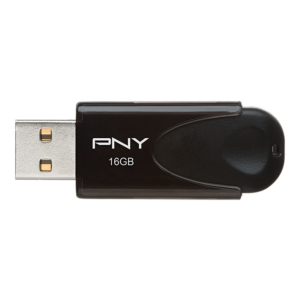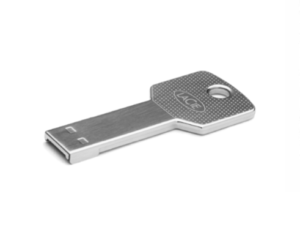Portable and convenient, what could go wrong? Celebrate National Flash Drive Day April 5th (and every day) safely using these tips
There’s likely one in your desk drawer. Or maybe yours is in a backpack. A keyring is another possibility, while others carry one tucked within a Swiss Army Knife.
We’re talking about thumb drives. The memory sticks—also known as USB, jump and flash drives—are among the most popular computer accessories ever manufactured. Commonly accepted as being introduced in 1984 by Toshiba engineer Fujio Masuoka, flash memory enabled portable storage drives’ popularity to soar in the 2000s. The devices, capable of storing and transferring large amounts of data with ease, have become so commonplace you can buy them in grocery stores, just like bread and milk.
Flash drives, and the corresponding simplicity and convenience they provide, are now commemorated with a national day of their own: April 5th. That’s not the date when Masuoka introduced his innovation at the International Electronics Developers Meeting, though, no. April 5th marks the date three M-Systems scientists filed for US patent US6148354A, “Architecture for a Universal Serial Bus-Based PC Flash Disk,”, a move that paved the way for the marriage of practicality between inexpensive and compact flash-array memory chips and easy-to-use USB ports.
The rest is history.
Just plug a thumb drive into a computer and it usually works. Copying and transferring files typically requires only dragging-and-dropping the files and folders in question. At most you might have to format the flash drive to match your Windows or Mac filesystem, unless the manufacturer was smart enough to simply configure the drive using exFAT, which is compatible with both platforms.
Thumb drives are so easy to use and convenient that they’ve given rise to a unique vulnerability known as USB drop (and drive-by) attacks. Wielding such a nefarious strategy, cybercriminals infect the devices and leave them in parking lots, on sidewalks and in other public places. Finders often cannot resist connecting the USB flash drives they’ve found to a computer to see what’s on it or to use the flash storage stick for their own use. The only problem is, upon connecting to the computer, malicious files stored on the drive infect the computer and, potentially, the broader network and other resources. For this and other reasons, including the ease with which USB drives permit transferring potentially sensitive files, numerous governments and military agencies have banned flash drive use.

Regardless, such prohibitions haven’t really dampened flash drive adoption or appeal. The devices continue proving a best seller. With thumb drives holding up to 2TB or more of data, and 1TB versions available for as little as $29 in both traditional USB-A and newer USB-C formats, they remain a popular option that often eliminates the headaches sometimes associated with transferring files over a network or via cloud services.
There are other dangers, however. USB drop attacks aren’t the only risk involving thumb drives.
The flash drive’s compact and portable nature makes the storage gadgets easy to lose or misplace. Sensitive, proprietary, financial and personal information can be easily accessed by others, including unauthorized users or malicious actors. The security conscious—and any flash drive user, really—should always follow one recommended best-practice step. They should encrypt flash drives to protect the contents from unauthorized access, should the memory stick be lost or stolen.
While flash drives typically prove reliable and retain data for extended periods of time, removing (or accidentally nudging) a memory stick while a computer is reading or writing data to the drive can corrupt its contents. Occasionally critically important data can be seemingly lost. We’ve had to run file recovery routines more than once on flash drives to recover wedding photos, financial information and other important data that was, for whatever reason, not backed up to any other source.
File recovery programs are, fortunately, surprisingly effective. Just because you’ve deleted files from a flash drive doesn’t mean someone else can’t recover that information. In many cases, in the secondhand market, those purchasing used thumb drives can sneak peaks at the data the memory stick previously stored. One study found more than 65 percent of USB drives purchased used in the US and the UK contained recoverable data—including intimate images and financial info—from previous users. For this reason, unless you’ve never used the device, we don’t recommend selling an old USB drive, especially when one’s stored sensitive, professional or private data.
Perhaps the most worrisome development concerning USB flash drive risk, while a rarity, just made headlines. In March 2023, an Ecuadorian journalist suffered minor injuries upon connecting an unexpected USB drive received from an unknown source to his computer. The connection caused explosives packed inside the flash drive to detonate. News reports state the thumb drive potentially contained a white crystalline chemical known as Royal Demolition Explosive (RDX), sometimes used in grenades.
If you stick to using thumb drives from trusted resources, odds are you won’t encounter such dramatic problems. In fact, employed properly, flash drives offer significant file transfer and storage advantages. So feel free to celebrate the ease of use the portable memory gadgets offer. Their very convenience is among their best traits.
As a best practice, though, never plug an unknown flash drive into your computer. The USB stick could contain malicious code, or worse. There have even been reports of doctored thumb drives discharging electricity in such a way as to damage the computer to which they’re connected, too. So if you’re unable to confirm a USB key is safe or from a trusted source and reputable manufacturer, skip the temptation to view its contents or use the USB accessory for data storage.

LaCie USB Key
Whenever storing personal or professional files—including photos, videos, documents, spreadsheets and other information—you wouldn’t want published on the Internet, don’t forget to also first encrypt the flash drive to make it more difficult for any unauthorized party to recover its contents. Both Windows PCs and Macs offer their own native data encryption technologies that work well, so take a moment to leverage the protection of the corresponding BitLocker and FileVault safeguards. And never store the corresponding decryption key with the thumb drive, as that serves only to provide malicious users with the key needed to unlock access.



